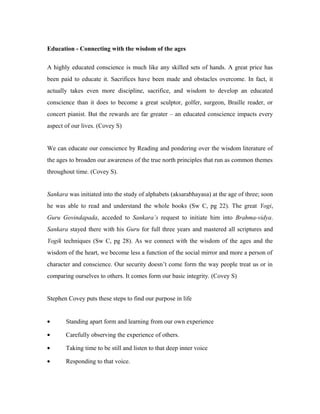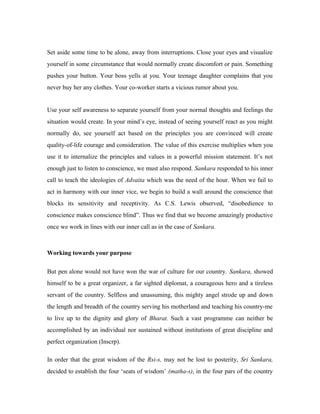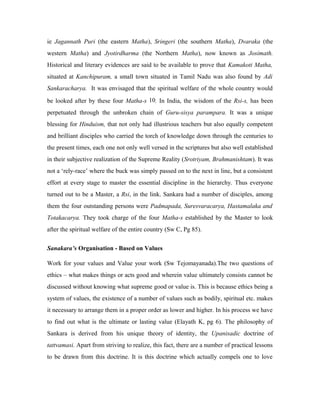The life of Adi Shankara - A Management lesson
- 1. THE LIFE OF ADI SHANKARA – A MANAGEMENT LESSON - Radhakrishnan Pillai (Director of Atma Darshan, Radhakrishnan is a research Student at Chinmaya International Foundation (CIF) in the subject of Kautilya’s Arthashastra) Sankara is not an individual. Sankara is an institution. No single person could ever have achieved what he had achieved in his short span of life of 32 years. No master or Prophet had ever achieved so much, for so many, in so short a time. Very often this tempts us to consider he was an avatara. Sankara is a Majestic entity striding over the total achievements of ordinary folk; through a quieter evaluation we shall find that Sankara’s work represents the total turnover of a highly competent person, working intensively every hour of the day, under conditions of the highest mental and intellectual efficiency (Sw C, Frwd). Sankara, was indeed a true leader of men, an organizer non parallel. His vision in establishing the Matha-s, centers radiating India’s ageless message of Sanatana-Dharma at various strategic points, his unbelievably extensive travels, in the bullock-cart age, from Kerala in the extreme south to Badrinatha, in the extreme north, to Kamarupa, in the East and Dvaraka, in the West, meeting discussing and debating with scholars, princes, pagans and people in all walks of life. Personality of Sankara Sankara’s life and teachings portray a perfect man, highly competent and supremely efficient. A brief profile of his personality has been summarized by Swami Chinmayananda (Sw C, pg 55) • He was distinguished in all sytems of Yoga. • Foremost in the field of Jnana Yoga, the Perfect Jnani. • Foremost in the field of Karma Yoga, the ideal of all Karma Yogi-s.
- 2. • Foremost in the field of Bhakti Yoga, the noblest of Bhakta-s worthy of emulation. • Unsurpassed in the field of Hatha Yoga • Master in both the knowledge and practice of the Tantrik system. • Foremost among teachers, a ‘Mobile University’ sympathetic yet relentless, the world teacher, Jagadguru. • A perfect organizer who established the great institutions in the four quarters of the country which remain, even today, the beacons of spirituality • A far-sighted statesman who integrated the country as a cultural unit and laid firm foundation to it. (Even today, India is bound together as one nation not by one political, economical or secular programmes but one cultural foundation based on its spiritual heritage) • An exemplary Man of letters, his style has the mathematical precision of a scientists, vividity of expression of a poet laureate and unity of vision of a spiritual master, coupled with simplicity and straightforwardness of presentation. • Above all, a down to earth man whose heart throbbed with compassion and sympathy for all men and beings irrespective of weather they were rich or poor, learned or illiterate, Brahmana or a Chandala. Studying the life of Sankara is a Management education by itself It was indeed a vast programme that Sankara had to accomplish within the short span of about 20 effective years; for at the age of thirty two he had finished his work and had folded up his manifestation among the mortals of the world (Sw C, pg 2).Establishing the matha-s, opening temples, organizing halls of education, and even prescribing certain ecclesiastical codes, this mighty Master left nothing undone in maintaining what he achieved (Sw C, pg 3). Understanding how is did this and making a deep study of it is an Education by itself. For Management Professionals each event of his life will unfold great insights into his Management style.
- 3. Education - Connecting with the wisdom of the ages A highly educated conscience is much like any skilled sets of hands. A great price has been paid to educate it. Sacrifices have been made and obstacles overcome. In fact, it actually takes even more discipline, sacrifice, and wisdom to develop an educated conscience than it does to become a great sculptor, golfer, surgeon, Braille reader, or concert pianist. But the rewards are far greater – an educated conscience impacts every aspect of our lives. (Covey S) We can educate our conscience by Reading and pondering over the wisdom literature of the ages to broaden our awareness of the true north principles that run as common themes throughout time. (Covey S). Sankara was initiated into the study of alphabets (aksarabhayasa) at the age of three; soon he was able to read and understand the whole books (Sw C, pg 22). The great Yogi, Guru Govindapada, acceded to Sankara’s request to initiate him into Brahma-vidya. Sankara stayed there with his Guru for full three years and mastered all scriptures and Yogik techniques (Sw C, pg 28). As we connect with the wisdom of the ages and the wisdom of the heart, we become less a function of the social mirror and more a person of character and conscience. Our security doesn’t come form the way people treat us or in comparing ourselves to others. It comes form our basic integrity. (Covey S) Stephen Covey puts these steps to find our purpose in life • Standing apart form and learning from our own experience • Carefully observing the experience of others. • Taking time to be still and listen to that deep inner voice • Responding to that voice.
- 4. Set aside some time to be alone, away from interruptions. Close your eyes and visualize yourself in some circumstance that would normally create discomfort or pain. Something pushes your button. Your boss yells at you. Your teenage daughter complains that you never buy her any clothes. Your co-worker starts a vicious rumor about you. Use your self awareness to separate yourself from your normal thoughts and feelings the situation would create. In your mind’s eye, instead of seeing yourself react as you might normally do, see yourself act based on the principles you are convinced will create quality-of-life courage and consideration. The value of this exercise multiplies when you use it to internalize the principles and values in a powerful mission statement. It’s not enough just to listen to conscience, we must also respond. Sankara responded to his inner call to teach the ideologies of Advaita which was the need of the hour. When we fail to act in harmony with our inner vice, we begin to build a wall around the conscience that blocks its sensitivity and receptivity. As C.S. Lewis observed, “disobedience to conscience makes conscience blind”. Thus we find that we become amazingly productive once we work in lines with our inner call as in the case of Sankara. Working towards your purpose But pen alone would not have won the war of culture for our country. Sankara, showed himself to be a great organizer, a far sighted diplomat, a courageous hero and a tireless servant of the country. Selfless and unassuming, this mighty angel strode up and down the length and breadth of the country serving his motherland and teaching his country-me to live up to the dignity and glory of Bharat. Such a vast programme can neither be accomplished by an individual nor sustained without institutions of great discipline and perfect organization (Inscrp). In order that the great wisdom of the Rsi-s, may not be lost to posterity, Sri Sankara, decided to establish the four ‘seats of wisdom’ (matha-s), in the four pars of the country
- 5. ie Jagannath Puri (the eastern Matha), Sringeri (the southern Matha), Dvaraka (the western Matha) and Jyotirdharma (the Northern Matha), now known as Josimath. Historical and literary evidences are said to be available to prove that Kamakoti Matha, situated at Kanchipuram, a small town situated in Tamil Nadu was also found by Adi Sankaracharya. It was envisaged that the spiritual welfare of the whole country would be looked after by these four Matha-s 10. In India, the wisdom of the Rsi-s, has been perpetuated through the unbroken chain of Guru-sisya parampara. It was a unique blessing for Hinduism, that not only had illustrious teachers but also equally competent and brilliant disciples who carried the torch of knowledge down through the centuries to the present times, each one not only well versed in the scriptures but also well established in their subjective realization of the Supreme Reality (Srotriyam, Brahmanishtam). It was not a ‘rely-race’ where the buck was simply passed on to the next in line, but a consistent effort at every stage to master the essential discipline in the hierarchy. Thus everyone turned out to be a Master, a Rsi, in the link. Sankara had a number of disciples, among them the four outstanding persons were Padmapada, Suresvaracarya, Hastamalaka and Totakacarya. They took charge of the four Matha-s established by the Master to look after the spiritual welfare of the entire country (Sw C, Pg 85). Sanakara’s Organisation - Based on Values Work for your values and Value your work (Sw Tejomayanada).The two questions of ethics – what makes things or acts good and wherein value ultimately consists cannot be discussed without knowing what supreme good or value is. This is because ethics being a system of values, the existence of a number of values such as bodily, spiritual etc. makes it necessary to arrange them in a proper order as lower and higher. In his process we have to find out what is the ultimate or lasting value (Elayath K, pg 6). The philosophy of Sankara is derived from his unique theory of identity, the Upanisadic doctrine of tattvamasi. Apart from striving to realize, this fact, there are a number of practical lessons to be drawn from this doctrine. It is this doctrine which actually compels one to love
- 6. one’s neighbour as oneself. It forces one to treat not only human beings but all living beings as equal and love them as one loves oneself (Elayath K, pg 11). In a successful organization values are the real boss. Values are to guide your behavior, not for you to guide others. You’re a leader, not the police. At the same time, though, you have to ensure the organization is internally aligned – everyone singing from the same hymn book. You can’t impose agreement to values any more than you can to goals, but you can, and must, impose conformity. If people don’t respect your values, then they work elsewhere. Goals are for the future – Values are now. Goals are set – Values are lived. Goals change – Values are rocks you can count on. Goals get people going. Values sustain the effort. (Blanchard and Bowles) Sankara not only found a value in the work he was doing but also made his disciples feel the value of their work. The most successful organizations are the ones in which all the team members work with common values. Documenting your work and let your subordinates take over “Managers keep control by pretending information is sensitive and withholding it. It’s great for power trips but it doesn’t lead to trust. If you want your team to Gung Ho, you have to tell the whole truth, and that means information belongs to everyone (Blanchard and Bowles). Adi Sankara, not only kept an open door policy to teach his disciples but documented his works for the sake of generations to come. The Master par excellence that Sankara was, he did not stop at culturing the intellect of this students, but carefully developed their hearts as well through the vast amount of devotional literature which streamed out of his bosom (Sw C, pg 60). Sankara’s compositions can be broadly divided into three sections, Bhasya-s (commentaries), Prakriya or Prakarna Grantha-s (Books dealing with the
- 7. fundamental concepts of Vedanta) and Stotra-s (Hyms and meditation verses) (Sw C, pg 57). A total of 113 compositions of Sankara, have been discovered (Sw C, Pg 125-128). A lot of research in unearthing his works is going in various institutes across India. By setting the key goals and values, you define the playing field and the rules of the game. You decide who plays what position. Then you have to get off the field and let the players move the ball……” (Blanchard and Bowles) At the age of thirty two Sankara wished to give up his body at the sacred place of Kedaranath. His disciples were asked to pass down the eternal wisdom of the scriptures through the Guru-sisya parampara, for the generations to come. The disciples requested the Acharya (the teacher) to give instructions in this regard so that the wisdom of the Ris- s would not be lost to future generations. He then dictated a book, Mahanusasanam, setting out rules and disciplines to be followed in the administration and working of the Matha-s. He then gave out the ten verses (Dasa Sloki), the essence of the Vedantic teaching, and the particular points for special contemplation. The master then disappeared into the Himalayan Valleys. The disciples came down to the plains to fulfill the work, so lovingly entrusted to them by their incomparable master (Sw C Pg 53-54). Conclusion Today, there is throughout the country a great enthusiasm in Sankara, the signs of revival are everywhere around us. On Sri Sankara Jayanti day, we find celebrations everywhere. Unfortunately, none of these thundering platforms successfully brings out the personality of this great Master. A lot is known about Adi Sankara, but very few know of the ‘Sankara’. The more we learn to adore him, not as a divine incarnation but as a sincere man inspired to serve the country and reconquer the nation from its slavery to alien ideologies, the more we shall successfully pay our tribute to our culture (Sw C Pg4),
- 8. As we study the life of Adi Sankara we start understanding Management not just as a mere academic subject but as a ‘mindset’ that is developed through education, vision, dedication and selfless activity performed for a higher and noble cause. References: (Sw C) Swami Chinmayananda, Sankara the Missionary, Central Chinmaya Mission Trust, 1978 (Elayath K) Dr. K.N.N. Elayath, The Ethics of Sankara, Department of Sanskrit University of Calicut, 1990 (Covey S) First Things First, Stephen Covey with Roger Merrill & Rebecca Merrill (Covey S) The Seven habits of highly effective people, Stephen R. Covey (Blanchard and Bowles) Gung Ho!, Ken Blanchard / Sheldon Bowles (Inscrp) The inscriptions at ‘Adi Shankara Nilayam’, Chinmaya International Foundation (CIF),Kerala radhakrishnan@atmadarshan.com








